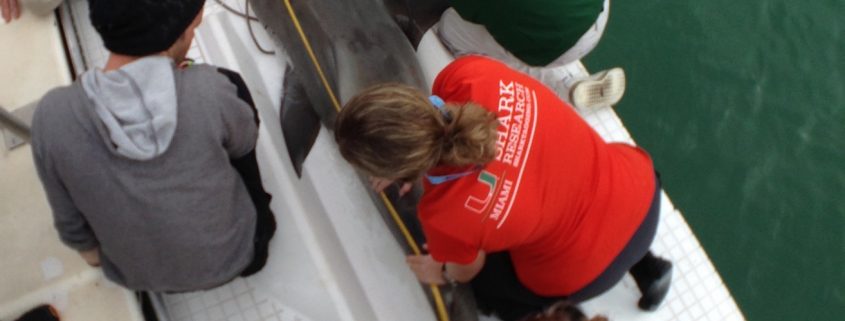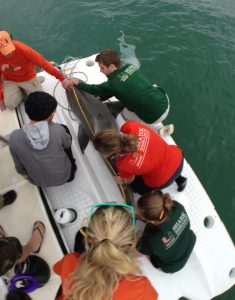Shark Tagging with Citizen Scientists
by Alison Enchelmeier, RJD student
This past Thursday and Friday, the RJD crew spent two days tagging with a group of citizen scientists. Our guests met us at the boat at 9:00 am and we set off for one of our usual spots, Safety Valve. I’d been on a trip there the previous week and we had caught a variety of sharks, so I was hopeful we would be just as lucky this week. We set out lines and Dr. Hammershlag explained to our guests how we catch sharks, work up sharks, and the research involved for each sample and measurement. After leaving our lines soak for an hour we returned to pull up the first line. Our day began with a nurse shark on line three, but before we could pull it onto the boat it got off the line. The citizen scientists were disheartened by the loss, worried that the lost nurse would be the only shark they would see. Their fears were unfounded as two lines later we caught another nurse. Over the course of the day we remained busy as we caught six more nurse sharks ranging from 2.09 m (6.86 ft) to 2.63m (8.63ft) and one bull shark that came off the line before we could bring it to the boat. With a successful day of seven nurse sharks we returned to Crandon Marina for the evening.
On Friday we decided to fish closer to shore to try and find a different variety of sharks. We set our lines out along Bear Cut and RSMAS and measured water temperature, dissolved oxygen, and salinity while we waited for the lines to soak. All conditions seemed to be in our favor as the very first line we pulled up wriggled with the weight of a shark. As the line reeled in we held our breath, was it a nurse shark or something else? As the fin broke the surface we had our answer, a bull shark!
Jake Jerome and Dr. Hammershlag pulled the 2.19m (7.2ft) female onto the boat. We did our usual workup on the shark before Neil implanted an acoustic tag under her skin. The tag will be used for the Urban Shark Project, a study on sharks in urbanized environments. After returning her to the water we continued to pull lines. We didn’t come across anything until line 15. We pulled up another female bull, this one larger than any bull shark I had seen before, 2.9m (9.5ft). After the workup she was fitted with a SPOT tag and released. As we pulled lines that day we could see people swimming and paddle boarders paddling. The fact that both the sharks and beach goers were coexisting in the same area really brought home he fact that humans aren’t on sharks’ menu.
In two days we caught seven nurse and two bull sharks, quite the successful trip. Thank you to our citizen scientists for joining us on this trip. I’m sure they had as much fun as we did!






Leave a Reply
Want to join the discussion?Feel free to contribute!